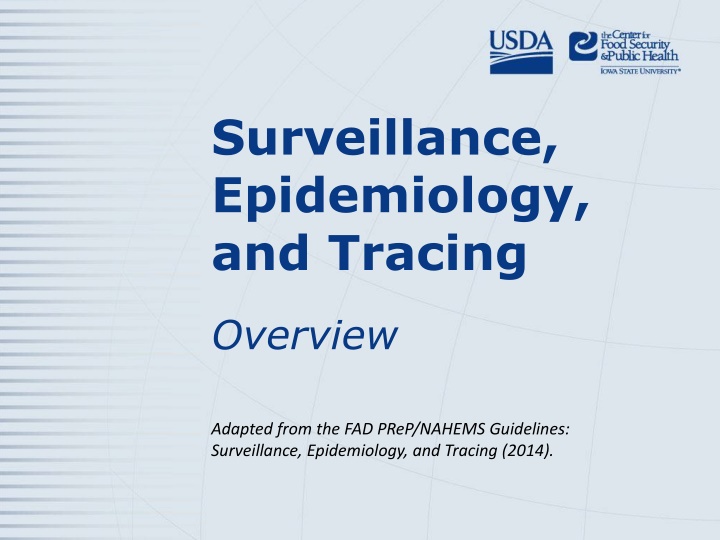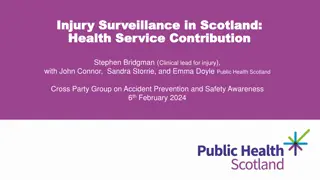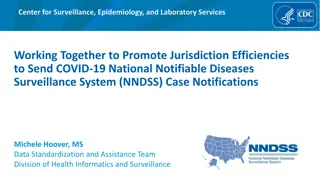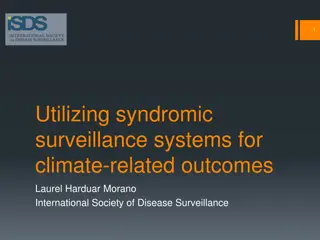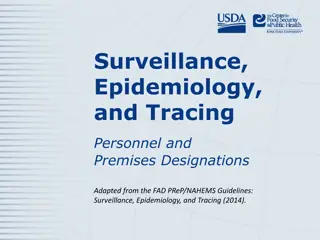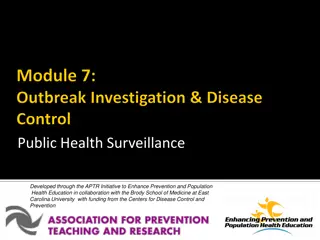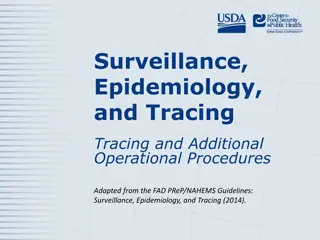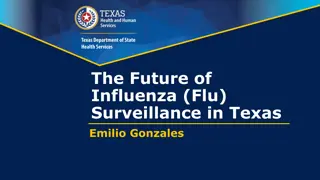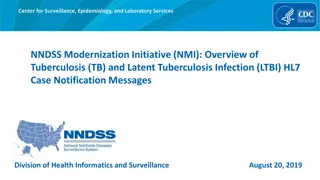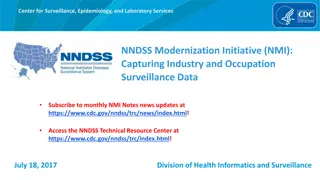Surveillance, Epidemiology, and Tracing Practices
This presentation provides an overview of surveillance, epidemiology, and tracing activities in the context of foreign animal diseases. It covers the purpose, definitions, and key principles involved in detecting, understanding, and controlling diseases. Techniques for data recording, analyzing disease distribution, and tracing potential sources of disease spread are discussed.
Download Presentation

Please find below an Image/Link to download the presentation.
The content on the website is provided AS IS for your information and personal use only. It may not be sold, licensed, or shared on other websites without obtaining consent from the author.If you encounter any issues during the download, it is possible that the publisher has removed the file from their server.
You are allowed to download the files provided on this website for personal or commercial use, subject to the condition that they are used lawfully. All files are the property of their respective owners.
The content on the website is provided AS IS for your information and personal use only. It may not be sold, licensed, or shared on other websites without obtaining consent from the author.
E N D
Presentation Transcript
Surveillance, Epidemiology, and Tracing Overview Adapted from the FAD PReP/NAHEMS Guidelines: Surveillance, Epidemiology, and Tracing (2014).
This Presentation Introduction to when and why Definitions for technical terms Organizational structure Overview of Surveillance Plan FAD PReP/NAHEMS Guidelines: Surveillance, Epi, and Tracing - Overview USDA APHIS and CFSPH
Surveillance, Epidemiology, and Tracing Activities FAD PReP/NAHEMS Guidelines: Surveillance, Epi, and Tracing - Overview USDA APHIS and CFSPH
Introduction Foreign animal disease (FAD) Terrestrial or aquatic disease or pest not known to exist in the United States High pathogenicity avian influenza Foot-and-mouth-disease Preventive measures for introduction Import restrictions Exclusion activities at borders/ports of entry Public education programs FAD PReP/NAHEMS Guidelines: Surveillance, Epi, and Tracing - Overview USDA APHIS and CFSPH
Introduction (contd) FAD investigation Initiated if an FAD is suspected Foreign Animal Disease Diagnostician Guidance Document 12001 APHIS FAD PReP Manual 4-0 Once an FAD is confirmed Surveillance, epidemiology, and tracing response components are activated Provide real-time understanding Enable decisions on interventions FAD PReP/NAHEMS Guidelines: Surveillance, Epi, and Tracing - Overview USDA APHIS and CFSPH
Purpose Surveillance, epidemiology, and tracing techniques are used to: Detect cases Understand disease characteristics Identify risk factors Provide information for decision-making Design and implement control measures Evaluate the effectiveness of the control measures implemented FAD PReP/NAHEMS Guidelines: Surveillance, Epi, and Tracing - Overview USDA APHIS and CFSPH
Definitions Surveillance An intensive form of data recording that encompasses gathering, documenting, and analyzing data Epidemiology The study of the distribution of disease in populations and of factors that determine its occurrence Tracing Information gathering on recent movements of animals, personnel, vehicles, and fomites to identify potential spread of disease, and source FAD PReP/NAHEMS Guidelines: Surveillance, Epi, and Tracing - Overview USDA APHIS and CFSPH
Zone/Area Designations Summary of Zone and Area Designations Infected Zone (IZ) Buffer Zone (BZ) Zone that immediately surrounds an infected Premises Zone that immediately surrounds an Infected Zone or Contact Premises Consists of an Infected Zone and Buffer Zone Control Area (CA) Surveillance Zone (SZ) Vaccination Zone (VZ) Zone outside and along the border of a Control Area Emergency Vaccination Zone is classified as either Containment Vaccination Zone (typically inside the control area) or Protection Vaccination Zone (typically outside Control Area). This may be a secondary zone designation FAD PReP/NAHEMS Guidelines: Surveillance, Epi, and Tracing - Overview USDA APHIS and CFSPH
Incident Command System Incident Command System (ICS) Flexible and scalable Number and names of deployed groups will vary Planning and Operations Sections Incident Action Plan FAD PReP/NAHEMS Guidelines: Surveillance, Epi, and Tracing - Overview USDA APHIS and CFSPH
Surveillance and Epidemiology FAD PReP/NAHEMS Guidelines: Surveillance, Epi, and Tracing - Overview USDA APHIS and CFSPH
Role of Surveillance During an FAD outbreak, surveillance plays a key role in: Identifying the infectious agent Determining the scope of the outbreak Assessing the effectiveness of eradication and control efforts Demonstrating a return to disease free status FAD PReP/NAHEMS Guidelines: Surveillance, Epi, and Tracing - Overview USDA APHIS and CFSPH
Surveillance Plan Elements Disease description Surveillance objectives Stakeholders and responsible parties Population description Case definitions Data sources Sampling methods Diagnostic tests FAD PReP/NAHEMS Guidelines: Surveillance, Epi, and Tracing - Overview USDA APHIS and CFSPH
Case Definitions Suspect case Animal showing clinical signs compatible with FAD Presumptive positive case Animal with clinical signs consistent with FAD and positive test results Confirmed positive case Agent has been isolated and identified using approved tests FAD PReP/NAHEMS Guidelines: Surveillance, Epi, and Tracing - Overview USDA APHIS and CFSPH
Data Sources Livestock producers Veterinarians Livestock organizations Disease reporting or notification systems Control programs Sentinel units Post mortem diagnostic specimen collection Wildlife data FAD PReP/NAHEMS Guidelines: Surveillance, Epi, and Tracing - Overview USDA APHIS and CFSPH
Sampling Methods Considerations for accurate and practical sampling methods: Sample type Sample size Random sampling vs. targeted sampling Sampling duration and frequency Sample areas/locations Availability of diagnostic tests Pooled testing FAD PReP/NAHEMS Guidelines: Surveillance, Epi, and Tracing - Overview USDA APHIS and CFSPH
Types of Specimens Blood or serum Skin or vesicular lesions Epithelial tissue or vesicular fluid Feces, rectal swabs, cloacal swabs, or genital tract swabs Nasal, oral, or oropharyngeal swabs Nasal discharge, saliva, tears Semen samples Tissues Tonsil, spleen, kidney, liver, lymph node, lung, brain, etc. Milk Environmental samples FAD PReP/NAHEMS Guidelines: Surveillance, Epi, and Tracing - Overview USDA APHIS and CFSPH
Core Functions Surveillance Ongoing data collection, analysis, interpretation, and dissemination Used to determine specific actions for FAD mitigation Field investigation Used to collect additional information about cases identified via surveillance Disease source, history of disease, etc. FAD PReP/NAHEMS Guidelines: Surveillance, Epi, and Tracing - Overview USDA APHIS and CFSPH
Core Functions (contd) Analytic studies Utilizes information gleaned from surveillance activities and field investigations Disease rates and risk factors Evaluation Effectiveness Efficacy Impact of activities FAD PReP/NAHEMS Guidelines: Surveillance, Epi, and Tracing - Overview USDA APHIS and CFSPH
Disease Occurrence Endemic Present in a population or geographical area at times Outbreak Occurrence of more cases of disease than expected in a given area, or a specific group, over a particular time period Pandemic An outbreak/epidemic that has spread over several countries FAD PReP/NAHEMS Guidelines: Surveillance, Epi, and Tracing - Overview USDA APHIS and CFSPH
Risk Factors A characteristic that is associated with an increase in the occurrence of a particular disease May include: Age Species Location Contact FAD PReP/NAHEMS Guidelines: Surveillance, Epi, and Tracing - Overview USDA APHIS and CFSPH
Epidemiological Principles Prevent contact between the FAD agent and susceptible animals Quarantine, movement controls, biosecurity procedures, target depopulation Stop production of FAD agent by infected or exposed animals Slaughter or mass depopulation Increase the disease resistance of susceptible animals to the FAD agent Emergency vaccination FAD PReP/NAHEMS Guidelines: Surveillance, Epi, and Tracing - Overview USDA APHIS and CFSPH
Phases of Investigation Generally, disease outbreaks are investigated in three phases: Descriptive phase Analytic phase Intervention phase FAD PReP/NAHEMS Guidelines: Surveillance, Epi, and Tracing - Overview USDA APHIS and CFSPH
Tracing Animal Movements FAD PReP/NAHEMS Guidelines: Surveillance, Epi, and Tracing - Overview USDA APHIS and CFSPH
Tracing Trace-back Animals, animal products, fomites, people, vehicles, equipment, and possible vectors that have been moved onto an Infected Premises Establish the origin of the agent/hazard FAD PReP/NAHEMS Guidelines: Surveillance, Epi, and Tracing - Overview USDA APHIS and CFSPH
Tracing (contd) Trace-forward Animals, animal products, fomites, people, vehicles, equipment, and possible vectors that have left the Infected Premises FAD PReP/NAHEMS Guidelines: Surveillance, Epi, and Tracing - Overview USDA APHIS and CFSPH
Additional Operational Procedures A variety of strategies are required to contain, control and/or eradicate an FAD Biosecurity Health and safety Personal protective equipment Cleaning and disinfection Quarantine and movement control FAD PReP/NAHEMS Guidelines: Surveillance, Epi, and Tracing - Overview USDA APHIS and CFSPH
For More Information FAD PReP/NAHEMS Guidelines: Surveillance, Epidemiology, and Tracing, and SOP: Surveillance http://www.aphis.usda.gov/fadprep Surveillance, Epidemiology, and Tracing web-based training module http://naherc.sws.iastate.edu/ FAD PReP/NAHEMS Guidelines: Surveillance, Epi, and Tracing - Overview USDA APHIS and CFSPH
Guidelines Content Authors (CFSPH) Kerry Leedom Larson, DVM, MPH, PhD, DACVPM Glenda Dvorak, DVM, MPH, DACVPM Janice Mogan, DVM Courtney Blake, BA Reviewers (USDA APHIS VS) Dr. R. Alex Thompson Dr. Lowell Anderson Dr. Steve Goff Dr. Fred Bourgeois FAD PReP/NAHEMS Guidelines: Surveillance, Epi, and Tracing - Overview USDA APHIS and CFSPH
Acknowledgments Development of this presentation was by the Center for Food Security and Public Health at Iowa State University through funding from the USDA APHIS Veterinary Services PPT Authors: Patricia Futoma, Veterinary Student; Kerry Leedom Larson, DVM, MPH, PhD, DACVPM Reviewers: Janice Mogan, DVM, Melissa Lang, BS
